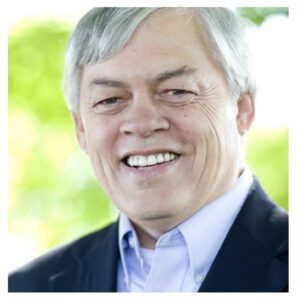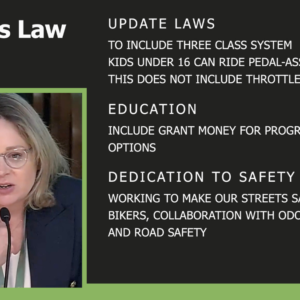
to say the “b” word.
Given the sad state of cycling in our local politics, I was eager to hear if the issue was on the radar screen of Oregon’s new governor, Kate Brown.
Brown’s first State of the State address on April 17th was a great opportunity to plant a flag in the ground and let everyone know that when she thinks of transportation she can see beyond the status quo.
And guess what? I was not disappointed. Governor Brown mentioned bikes — not once but twice! It was just what I needed to allay my lingering disappointment from when Portland Mayor Charlie Hales — who was a Portland commissioner in bicycling’s heyday in the 1990s and rode into office in part for his progressive transportation bona fides — didn’t mention bikes at all in his State of the City address back in January.
Biking’s big moment in the spotlight came in a part of Brown’s speech where she was trying to make the case for infrastructure investment (the legislature is debating a big transportation package but it has stalled of late).
Here’s the excerpt (full text here):
“As we all know, a safe and efficient transportation system is essential to getting goods to market, workers to their jobs, and creates a desirable quality of life that attracts innovative people to our state.
And ultimately, when we look at our transportation system, we must be mindful of how Oregonians choose to get around. No matter how we do — whether we walk to school, drive to work, catch a train for a family visit, or bike to the gym — the system we travel on needs to get us there safely.
Advertisement
Looking ahead, however, the resources needed to operate, preserve, and make much-needed improvements are non-existent.We need to invest in passenger rail, freight rail, bicycle routes and other transportation alternatives. As anyone in the tri-county area can attest, congestion is a very real problem that threatens our quality of life.”
The “alternatives” part aside (that’s sort of a pet peeve), this is a pretty good sign that Governor Brown “gets it” when it comes to bikes and that she’ll be a supporter of bike-related funding when the time comes. It’s also no surprise given that bike advocates have already given her positive reviews.
We’re looking forward to hearing more from Governor Brown about how bicycling can fit into Oregon’s future. The latest rankings from the League of American Bicyclists don’t even put us in medal contention. Hopefully Governor Brown can change that.





Thanks for reading.
BikePortland has served this community with independent community journalism since 2005. We rely on subscriptions from readers like you to survive. Your financial support is vital in keeping this valuable resource alive and well.
Please subscribe today to strengthen and expand our work.
“we walk to school, drive to work, catch a train for a family visit, or bike to the gym”
I like the multi-modal language, the nod to not doing everything by car. Biking to the gym, though? Hm. Next time around I suspect we’ll see biking a little earlier in the list.
[img [/img]
[/img]
I like “bike to the gym”. Driving to the gym always seemed like such a silly contradiction; I’m going to sit in a cushy chair while a machine lets me avoid exercise so I don’t get tired before I exercise.
Regardless, we’re over-analyzing this. I look forward to Gov. Brown’s term.
If she had said “bike to the grocery store in the rain”, it would need too much explanation. Maybe it was supposed to be “bike to work”, “drive to the gym”.
I’d be all for that alternative, Eric.
We’ve had a version of this conversation once before here:
http://bikeportland.org/2011/06/29/mayor-talks-tough-on-enforcement-at-street-smart-campaign-kickoff-55682#comment-1884057
I work for a freight company and there were kid’s bikes in the bike cage for Bring Your Kid To Work day…
Bike to gym to use exercise equipment that tones and strengthens the rest of your body.
Love of bikes doesn’t make cycling a full body workout.
…or just ride more, skip the overpriced gym and do core work at home and know you’re as beautiful as can be that way. (Sorry- just the old hippie in me talking)
But… But! How will I get my buff beach body?
/s
Oh wait, I sunburn in 15 minutes and am a mosquito magnet. I’m going back to my basement.
I bike to the climbing gym all of the time. It does rain a lot here in the winter, and you generally try to avoid climbing on wet rock.
… climb to work, joggle to the theatre, squirt boat to the timbers game, unicycle to the airport …
If I were to support her, I’d want to hear her say no expansion of car infrastructure, only maintenance. Everything else (bike, ped, train, bus) needs to be vastly expanded. I just hear her pandering here, to be honest. Not impressive.
If you want her to support your cause *and* get re-elected multiple times, you’ll need her to appeal to a broader audience than your narrowly stated concerns indicate.
Sometimes I would like a politician to be a one-termer that gets the dirty NECESSITIES done. Just my opinion, of course.
People formerly thought drinking and driving was no big deal. The campaign that MADD undertook to arrive at the current social taboo of such behavior took 20 years to achieve, and still has a ways to go. Anything that can be done quick and dirty, can usually be undone just as fast.
I still think the overton window in Oregon is too far right; it needs to be shifted by her doing more than just bland statements.
this country would be so much better off with strong term limits.
I completely agree with Jeg, where you see “narrowly Stated” I see a focused Goal.
In the majority of situations in Life, if we want to accomplish a task then we have to focus on specific and attainable goals.
I think that is where the voting public are duped by Politicians, by generalizing everything they (the politicians) can say they’ve accomplished something because there goal was so broad and generalized they can put their name on just about anything.
Holding a politician to a specific goal is not narrowly focused, it is holding that politician accountable and asking them to do their job effectively.
If we want anything done in this state and city that needs to change.
Agree that most talk I hear coming from politicians’ mouths these days (on transportation issues) sounds like more mealy-mouth pandering. Actions speak volumes louder, so when I start seeing significant amounts of money actually allocated, meaningful amounts of bike and transit related projects actually started and completed, more policy-related economic incentives to leave your car parked (in your own driveway) actually implemented, and so on, then I will rally to their sides and compliment them for a job well done. Until then, I’ll keep riding my bike anyway, wherever I can, whenever I can, and try to model the change that I want to see.
STOP TALKING, START DOING.
You’re absolutely right. I mentioned only rhetoric. The true yardstick is action.
Think we can get her to run for Mayor?
A ‘safety first’ message would resonate with many voters in Portland.
…or president?
What if ODOT suddenly becomes the big bike promoting force?
*mind blown*
Would be less surprised by The Porcine Air Force bringing world peace.
one of the PBOT engineers coined a phrase in regards to improbable projects, “we’ll get to that right after building the porkports’.
State laws and policies could certainly have a bigger and more immediate impact on biking than any infrastructure project. Consider statutory speeds, penalty classifications, fines, driver licensing, idaho stop, safe passing distance, static photo radar, gas tax, etc.
In the Oregonian today, news that the Oregonian house and senate have passed a bill that would allow people riding motorcycles to lane split. Rose’s story. He writes that given what seems to be Gov Brown’s emphasis on improving transportation, she’ll make the bill law.
It’s not too much of a stretch in reasoning to figure the law would possibly also allow people riding bikes to lane split amongst motor vehicles. Rose’s story cites a bunch of numbers and a study suggesting that the practice doesn’t result in collisions. I suppose, as long as someone stuck in crawling traffic doesn’t open their door momentarily, to spit on the ground and so forth.
Motorcycles have full time headlights, and they’re generally bigger and almost always heavier than bikes. Those things might help them be better prepared than people on bikes, for the occasional entrance of something into the narrow space between two lanes of motor vehicles.
Ugh. Lane-splitting is legal in some places, and having lived in one for a while, I did not like it at all, from either perspective. (The scenario you imagine of someone opening their door is actually illegal and I’ve heard stories of it being prosecuted as assault.)
With a motorcycle, part of the justification for splitting is that the motorcycle will easily out-accelerate any car off the line and have the lane to themselves again by the time they get across the intersection.That’s less true today with more electric vehicles than it used to be, and it doesn’t apply to bicycles.
The whole traffic flow through the intersection breaks down if there are more than a couple of motorcycles lined up splitting lanes.
Lane-splitting while in motion is not supposed to happen, but in my experience it did happen a lot and is fairly terrifying at freeway speeds even with the wider lanes, and that contributes to my objection to legalizing it.
In areas with narrow lanes (something I think we should take more advantage of), lane-splitting becomes dangerous, and I don’t think any of the existing laws limit lane-splitting only to certain widths.
I agree with everything you said. I think it’s going to be a mess and encourage us to talk about “safety” in a way that includes widening lanes. In other words, a political trap.
When I was in France, all of the motorcycles were weaving in and out of traffic at highway speeds. It looked pretty dangerous and was very annoying.
For a while, I was working in East Los Angeles and going to school in Irvine. My shift ended at 6:10 and class started at 7:00. Since I-5 resembles a parking lot at that time of day, I and my motorcycle split lanes every day to get to class on time. As long as traffic was going less than 30 miles per hour (or so), I felt very comfortable: lines of sight are good, motorcycles tend to sit you fairly high relative to sedan drivers, and it’s usually very clear when a drive ahead of you intends to change lanes.
That said, I’m far less comfortable splitting lanes on surface streets. Drivers change lanes more often, and with less warning, than they do on freeways. The only time I’d split lanes on surface streets was when traffic was stopped like, e.g., at a backed-up stoplight.
“…(The scenario you imagine of someone opening their door is actually illegal and I’ve heard stories of it being prosecuted as assault.)…” Tait
Cite a statute supporting your contention. It appears you’ve jumped to a scenario, one consisting of deliberately intending to hurt someone, that I did not pose. I don’t believe it is illegal to open the door of a car when the car is crawling along in for example, at rush hour traffic speeds of say, 5 to 10 mph. I’ve seen happen, exactly what I described.
In Oregon, it’d be under ORS163, and Oregon’s language — “Recklessly causes serious physical injury to another under circumstances manifesting extreme indifference to the value of human life” — is fairly typical. Opening your vehicle door in traffic (esp. if it’s moving!) is negligent and reckless. Doing so when it leads to a collision with a motorcycle is extreme indifference to the value of human life because a reasonable person should know that motorcycles colliding with doors is going to endanger the rider’s life. The fact it could have been done out of malice is just an additional aggravating factor. (I suppose if they could prove intent maybe it would upgrade the charge to manslaughter or something, but I don’t have those details.)
“With a motorcycle, part of the justification for splitting is that the motorcycle will easily out-accelerate any car off the line and have the lane to themselves again by the time they get across the intersection.”
Actually in the state of California (as in most states that allow splitting) it is legal because of 2 key reasons which are stated under the conditions of the law.
1) Motorcycles have been traditionally air cooled (i.e. most Harley Davidson’s) and because of this they need to be constantly moving to stay within their safe operating temps. Since most police forces have traditionally used air cooled Harley Davidson’s (until recent years) there needed to be a law allowing them to split lanes.
2) because it is much less safe (and just harder to do) for a motorcycle operator to stop and start a lot over short distances, especially in hi capacity freeways congestion conditions, lane splitting is “allowable” if traffic is moving less than 35 mph and the motorcycle cannot go any faster than 5 mph of what traffic is doing.
Notice I said “allowable” because when it comes to freeway lane splitting the law is very gray and motorcycles can be ticketed for it if an officer feels they are being unsafe. And the law was originally in place to allow CHP motorcycle officers to split lanes at discretionary speeds at any time.
It actually has nothing to do with “out-accelerating” cars from an intersection because that is illegal and extremely unsafe.
I taught “Motorcycle Safety certification” for MSF in California and this was a very consistent question from trainees. We actually discouraged it because it is extremely unsafe at any speed. Most collisions between motorcycle and car (in this context) happen because the car driver doesn’t see the motorcycle approaching from behind and because most drivers don’t check their mirrors when changing lanes (or even signal for that matter) It’s just bad defense and safe motorcycle operation. (hence my user name)
Thanks for the extra information.
I don’t ride a motorcycle in Oregon, but I see plenty of people riding motorcycles today (including some police), and the air-cooling doesn’t seem to “need” lane-splitting. (We’ve got a fairly large Harley Davidson dealership off I-205 near Oregon City, too.)
I understand the stop-start issue, but those conditions are also problematic for other traffic like trucks. Vehicles that can’t lane split just have to allow more distance, and motorcycles can do that, too.
Are there any studies about motorcycle-automobile accident rates for similarly-situated lane-splitting vs no-lane-splitting areas?
My sense of it is that conflict and risk increases when the speed differential between vehicles is greater. Lane-splitting is taking away some of the safety buffer while also increasing the speed differential and adding a more-vulnerable roadway user into the mix. How often do you see a driver begin to change lanes (close the buffer between their vehicle and the line) then abort when they see a vehicle in their blind spot? Yes, it’s the driver’s responsibility to safely operate their vehicle, but do you want to make it easier for them or harder? For those not already familiar, take a look at some of the split-lane videos (e.g. https://www.youtube.com/watch?v=Kz4ZGqfwNEM is the “I’m feeling lucky” result) for an example of admittedly bad, yet widespread behavior and what it feels like to be in that situation.
One of the cars I drive on I-5 sits low to the ground. I can’t see around the traffic that’s immediately surrounding me most of the time in that vehicle because it’s taller and wider than me. If a truck (semi especially, but even a passenger truck) is behind me and a truck is adjacent to them, I would be unable to see a motorcycle split-lane-ing until part of my vehicle — at least the mirrors — was/were already in front of them.
I think part of what’s attractive about lane-splitting is, as Paul H described, being able to move consistently and bypass traffic (that might be “parking lot” conditions). If we “need” or want to provide faster, less-congested transit for motorcycles, then I think a better and safer way to do that is to make a separate right-of-way for them the same way we do with bicycles on surface streets (i.e. a motorcycle lane). For the typical width of a car lane, we could probably fit both a motorcycle AND a bicycle lane.
I should have mentioned one other advantage of lane-splitting for motorcycles: not being at the back of the stopped line of traffic (to get rear-ended). That, too, would be addressed by a separate right-of-way.
because bikes are allowed to pass slower moving traffic on the left or right lane splitting by bikes in this state already has the same status as in california: not illegal.
i’m very glad that oregon has come to its senses on this issue.
“because bikes are allowed to pass slower moving traffic on the left or right lane splitting by bikes in this state already has the same status as in california: not illegal. …” soren
You’d better clarify what you’re saying, because what you’re describing does not sound like lane splitting.
In fairness, I’ve not read the Oregon bill proposing lane splitting for motorcycles to know exactly what it describes as lane splitting, but what I believe the term mainly refers to, is the practice of riding between two main lanes of traffic, rather than to the far right, or far left side of a road.
I hope the legislature has considered whether the bill they’ve worked on and voted on, will extend to bikes as well, or whether it should.
Lane splitting is not addressed in the ORS (except for motorcycles). As far as I can tell the only law that would prevent a cyclist from lane-splitting is 811.370.
However, other bike-specific statutes provide exceptions to 811.370 that enable cyclists to:
1) share lanes with other motorvehicles, if it is safe to do so.
2) pass on the right or left, if it is safe to do so.
As far as I can tell, lane-splitting is not-illegal for cyclists in OR.
Legal MC lane splitting has been needed here for a long time.
Governor Brown was expected to be more progressive than Kitzhaber. We’ll have to see how that plays out.
“It was just what I needed to turn around the depression I’ve been feeling …”
JM,
I hope you, and all reading here, realize that what you feel is generally your choice. How you choose to react to external slings and arrows is entirely up to you. If depression is the result of living in one of the best cities in the US to bike in, perhaps you need to take some time away, visiting a few of the lower quality cities, to adjust your perspective. Smooth sailing is a rare event, a chance to relax, and something to be enjoyed while it is happening, but it is also not as exciting as a broad reach on a rough and windy day.
“Bad times have a scientific value. These are occasions a good learner would not miss.” – Ralph Waldo Emerson
Don’t claim depression is a choice. That’s asinine.
Sort of like calling names?
JM’s use of the word, likely inaccurately, triggered my suggestions. And if you re-read my statement, I said ‘generally’. I am *fully* aware of the difference between being disappointed or frustrated and depressed.
Apologize.
Calling names? Saying an action is asinine is not calling your person asinine.
paikiala,
I hear you. Perhaps “depression” wasn’t the best word to use. I am not torn or up or truly depressed about the state of biking in Portland. It was just a word I typed at that time. I’ll consider changing it. I see now how it looks.
Anybody ever wonder if we spend too much time preaching to politicians and ignoring the majority of our fellow citizens; you know, the ones who vote, and don’t really bike all that much?
Fundamentally, so long as devoted cyclists remain a minority of the population (which we ARE), we remain a political minority, and we can shout to the politicians as loud as we want, but we might as well be pounding sand.
Seems to me that we should be throwing more efforts in with an organization that really is focused on evangelizing to get people out of their cars and onto bikes. If we can keep moving the needle, more people riding more bikes, the politicians will come around.
Alternatively, or in concert, using the tactic Seattle Greenways is using to shift the focus from mode to people. The safety of people, regardless of how they prefer to move about the city, should be one of, if not the, highest priority.
The reason we all spend so much time preaching to politicians is because we need the infrastructure to get more people out on their bicycles. Years ago, “I don’t feel safe” was one of the more-often-cited reasons why people said they didn’t bicycle more. It’s that feeling that (in part) drove the experiments with putting bike lanes on the opposite side of the car-park lane on streets, and adding bike boxes to intersections.
Where I live, the ‘majority’ of citizens recently lashed city council with an outcry against a road diet that included buffered bicycle lanes. Councilors were overwhelmed with email, letters, and even a petition demanding it be removed and put back to the way it was. As a result, when grants that were allocated for bicycling improvements came due, $400K in funding a vital connector between two Class I trails was threatened. Fortunately, the local bike community sent word around and not only was the council meeting well attended and sensible testimony heard, we invited a police officer to speak of the drop in number of citations, anecdotal lowered speeds, and lower reported incidents (all collision types). The vote was unanimously in favor, despite two councilors who had said they planned to vote against the project.
I completely agree with you that we should get more people out of cars and on their feet or onto bikes (or even into buses and trains). I agree wholeheartedly with Peter R that one of the best ways to do this (hand in hand with education) is to get people comfortable with recreational cycling first (http://bikeportland.org/2015/04/17/comment-week-bike-culture-bites-back-139592#comment-6349262).
Frankly I don’t want our government to vote in favor of the will of the majority of the population. I want them to vote for the best environment for ourselves and our children.